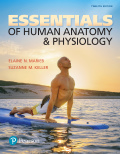
Concept explainers
Case summary:
Professor from Boston, who is in middle age, is in the Swiss Alps and studying astronomy. This professor lands 2 days ago and he intends to stay for the entire year. But, he observes that he is short of breath while walking the steps and also gets tired easily with any physical exercise or activity. After, few months, his symptoms gradually fade away and he feels good. When he gets back to United States, he undergoes a full physical exam and his results suggests that his erythrocyte count is increased from the normal level.
Characters in the case:
A middle aged college going professor.
Adequate information:
The erythrocyte count is higher than normal in a middle-aged college Professor.
To determine:
The rationale behind higher erythrocyte count in the given case and whether this phenomenon is irreversible or not.
Given information:
The person, in this case, had been in Swiss Alps for around a year. He is middle aged and a professor by profession. He is from Boston, which is situated at sea level. He had symptoms like shortness of breath and tiredness in the beginning but later subsided without any intervention.
Introduction:
This case is a classic example of secondary polycythemia. Polycythemia is defined as an abnormal increase in the number of erythrocytes or red blood corpuscles (RBCs) in the blood. As erythrocyte count is higher in this person, he can be diagnosed as having polycythemia.
Want to see the full answer?
Check out a sample textbook solution
Chapter 10 Solutions
EBK ESSENTIALS OF HUMAN ANATOMY & PHYSI
- How Fibrinoid necrosis can accumulate disease ? please Explain at your own wordsarrow_forwardYour patient has a diagnosis of atherosclerosis. Is your patient at a higher or lower risk for a thromboembolism? Explain your reasoning. asaparrow_forwardWhy do mature Erythrocytes lose their nucleus? give an in-text citation to support your claims.arrow_forward
- Neutrophils = 55 , Lymphocytes = 30 , Monocytes = 7 , Eosinophils = 3 , Basophils = 5 Based off these numbers would this person be considered healthy? Please explain your reasoning.arrow_forwardWhat can contribute to the elevated white blood cell count found in this patient? The patient's platelet count is elevated. Why would this occur? Would altitude affect the individual with sickle cell disease? If so, in what way?arrow_forwardEmily Wong, 17, is brought to the ER with a fever, headache,and stiff neck. You suspect bacterial meningitis. Would you expect to see an elevated neutrophil count in a differential WBC?arrow_forward
- Question 1 An 18yrs old woman from Ananekrom in the Asante- Akyem North District was presented to your consulting room with the following complaints; headache, photophobia, painful and stiff neck as well as vomiting. Upon physical examination, the patient was febrile(temperature, 38°C) with tachycardia. Her CSF sample was taken to the laboratory for further investigation. Her results came out with low glucose estimation of 1.2mmol/L and high protein estimation of 10.0g/dL. Gram staining results show numerous Neutrophils with Gram positive diploccoci- +++ (A) What condition does this patient's laboratory and other Findings suggest?arrow_forwardWhile analyzing a blood smear under a microscope, you are able to identify a large multilobed leukocyte with with large nuclei. Which of the following diseases would display this finding? Acute Myelogenous Leukemia (AML) O Idiopathic Thrombocytopenia Chronic Lymphocytic Leukemia (CLL) O Hodgkin Lymphomaarrow_forwardWhat is suspected when the hematocrit has decreased by 4% and the total bilirubin level is increased 5 days after transfusion? Question 8 options: a) Urticarial reaction b) Volume overload c) Delayed hemolytic transfusion reaction d) Acute hemolytic transfusion reactionarrow_forward
- A patient has been admitted to hospital after experiencing significant heat stress and an altered level of consciousness related to dehydration from a marathon race. In attempt to correct the problem, health care workers insert an intravenous catherter and infuse what should have been a physiological (isotonic) saline solution but later discover a mistake has been made and the solution was 5% sodium chloride. What changes do you expect to the erythrocytes (RBCs) of the patient and explain why?arrow_forward55-year-old white male college professor had been experiencing fatigue and shortness of breath when walking over the past several months. Getting more sleep at night did not help. He reported eating a balanced diet of fruits, vegetables, meat, and dairy products. Physical examination, he appeared slightly pale but had no other abnormalities. His laboratory results was a following: Hemoglobin 12.5 g/dL Hematocrit 32% RBC 4.2 X 1012/L WBC count within normal limits MCV 42 fL MCH 29.7 pg Urinalysis is normal Fecal occult blood found to be positive What is the most likely cause of this patient’s anemia? 2- What type of red cell morphology would be expected on a peripheral blood smear? What follow-up tests should be conducted? What do you expected the treatment for this patient would be? 5- What would you expected about the reticulocyte count to be…arrow_forwardsickle cell disease and its variants are genetic disorders resulting from the presence of a mutated form of hemoglobin . propose a proper therapeutic strategy to ameliorate or cure this disease.arrow_forward
 Human Physiology: From Cells to Systems (MindTap ...BiologyISBN:9781285866932Author:Lauralee SherwoodPublisher:Cengage Learning
Human Physiology: From Cells to Systems (MindTap ...BiologyISBN:9781285866932Author:Lauralee SherwoodPublisher:Cengage Learning Comprehensive Medical Assisting: Administrative a...NursingISBN:9781305964792Author:Wilburta Q. Lindh, Carol D. Tamparo, Barbara M. Dahl, Julie Morris, Cindy CorreaPublisher:Cengage Learning
Comprehensive Medical Assisting: Administrative a...NursingISBN:9781305964792Author:Wilburta Q. Lindh, Carol D. Tamparo, Barbara M. Dahl, Julie Morris, Cindy CorreaPublisher:Cengage Learning





